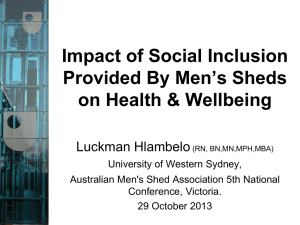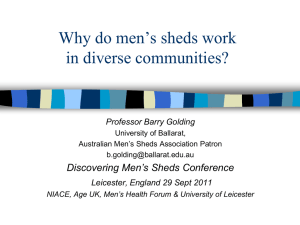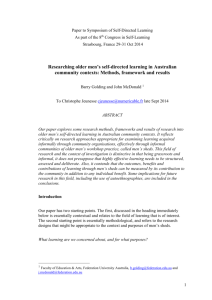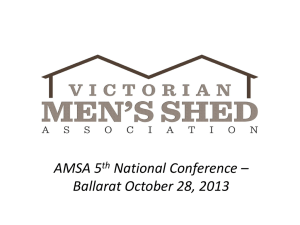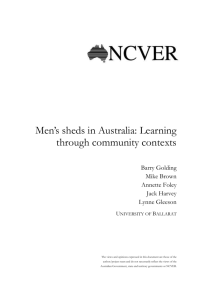1200 B Golding - Australian Men`s Sheds Association
advertisement
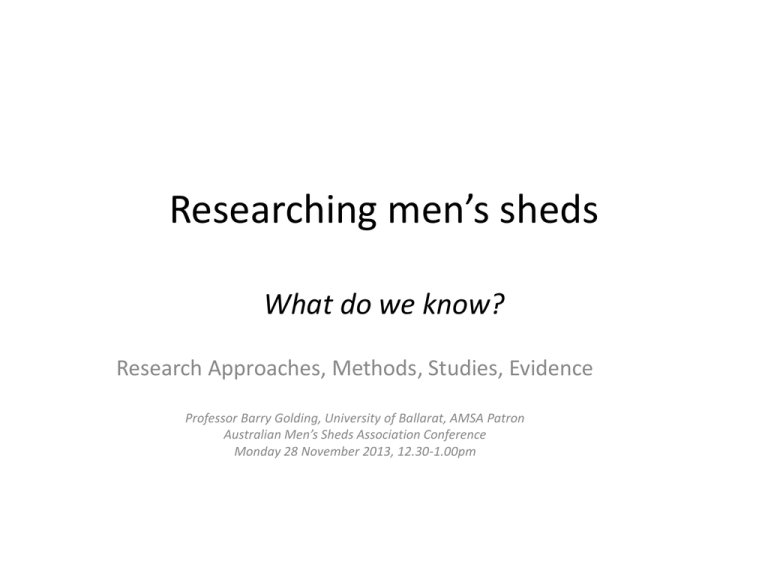
Researching men’s sheds What do we know? Research Approaches, Methods, Studies, Evidence Professor Barry Golding, University of Ballarat, AMSA Patron Australian Men’s Sheds Association Conference Monday 28 November 2013, 12.30-1.00pm Some research approaches • Case studies of individual sheds and/or shedder experiences • Comparative studies across many sheds, including between nations • The study of particular phenomena (eg men’s health, wellbeing, learning, depression), interviewing and/or surveying shedders • Longitudinal studies following impact and outcomes over time • Quasi-experimental studies comparing shedders with non-Shedders. • Narrative or systematic literature reviews and metaanalyses. Important starting observations • Some self evident things are very difficult to prove (“You don’t need a weatherman to tell which way the wind blows”, Bob Dylan) • Some simple, everyday phenomena and outcomes are still unable to be explained in terms of simple, single ‘causes’, e.g. gravity, poverty, depression) • Research on people and communities (and sheds) that produces ‘certain’, scientific knowledge is limited by ethical and practical considerations. • What we find out depends on how we study it and what assumptions we bring to the ‘problem’. A tree (shed) research analogy • What is a tree’s role? (to photosynthesize, to recycle carbon & nutrients, to complement an ecosystem?) • Which discipline should we use to study it? (a botanist, forester, conservationist, artist?) • Why should we do the study? (to prove or confirm a hunch, to make a new breakthrough?) • What level of proof is required, who needs it and for what reasons? (to decide on a tree’s value, fate or funding?) • Or are we interested instead in the forest? (and its relationship to other trees, plants, insects, animals, humans, etc) Typical Research Methods • • • • • Interview Survey Use of existing statistics Literature review Most studies are strengthened, as in building, by triangulation • Who is the research subject? (shedder, coordinator, community, partner, family?) • What role are we exploring? (health, learning, wellbeing, community contribution etc?) • From which disciplinary base, on what assumptions, for whom, for what purpose, and for what level of proof? Major Shed-Based, Mixed Method (Survey and Interview) Studies • Men’s sheds in Australia: Learning through community contexts (Golding et al., 2007) cited 47 times, 28 times externally. • Men’s sheds in Ireland: Learning through community contexts (Carragher, 2013) not cited • Men’s sheds in Australia: Effects on physical health and mental well-being, Ultrafocus Report for beyondblue, Full report (in preparation, October 2013) Some other important shed studies • Men’s sheds: Exploring the evidence base for best practice Hayes, R. & Williamson, M. (2007) La Trobe Uni; cited 11 times. • Men’s sheds: A strategy to improve men’s health Misan, G. et al. (2008) Spencer Gulf Rural Health School, cited 7 times • Houses and sheds in Australia: An exploration of the genesis and growth of neighbourhood houses and men's sheds in community settings. B Golding, H Kimberley, A Foley, M Brown - Australian Journal of Adult Learning, (2008 ) cited 11 times • More than a place to do woodwork: A case study of a community-based men’s shed Ballinger, M. et al. (2009) cited 17 times • Older men's participation in community‐based men's sheds programmes J Ormsby, M Stanley, K Jaworski - Health & Social Care in the Community ( 2010) University of South Australia, cited 9 times • The Taieri Blokes Shed: An ethnographic study Sunderland, J. (2013) Masters Thesis (in preparation), Otago Polytechnic, Dunedin New Zealand. Meta-analyses Critical reviews of all of the literature, biased towards peer refereed publications • A narrative review of men’s sheds literature: reducing social isolation and promoting men’s health (N. Wilson & R. Cordier, 2013, Health and Social Care in the Community, 21 (5): 451-463. [University of Sydney and JCU]) • Men’s sheds and other gendered interventions for older men: A systematic review and scoping of the evidence base (C. Milligan, S. Dowrick, et al., 2013 A Report for the Liverpool- Lancaster Collaborative (LiLaC) and Age UK, [Lancaster University, UK]) Key themes in the research from the UK Lancaster University (2013) review of Millgan et al. • Links between social activity and health and wellbeing • The value of qualitative insights into social capital • Older men and masculinity • Theoretical frameworks (WHO Determinants of Disadvantage & HIMM [Health, Illness, Men and Masculinities]) • Differences amongst older men and limited scope for successful interventions Some critiques from a meta-analysis after Milligan et al (2103 in the UK) • There is as yet no substantive evidence that involvement in men’s sheds has any significant effect on the health of older men • The evidence of positive effects on mental health and wellbeing is more extensive. • The benefits are particularly for men experiencing social isolation and loneliness • Sheds encourage men of diverse backgrounds, with specific health conditions, and have benefits for caregivers. Wilson and Cordier (2013) argue that • “Most of the evidence on health and well-being outcomes[from sheds] is either self report or anecdotal; what research has been conducted is either small scale or focused on men’s learning.” • “The range of variables that might contribute towards best practice in Men’s Sheds has not yet been adequately conceptualised, measured, tested or understood.” • “The Men’s Sheds movement is at a crossroads in terms of their wider male health role.” (ie The overt resistance in sheds to foregrounding health as an agent for male health initiatives presents sheds and health departments who might fund them with a conundrum) Need for new research after Milligan et al. (2013) UK review • Good quality research for potential funders and guidance for good practice. • Research on gendered interventions, particularly through men’s sheds for older men. • Research that brings together separate theories of masculinity and social isolation. • Longitudinal and comparative studies. • Mixed method studies with validated survey tools. Some New Findings (Synthesis from DRAFT findings of the Australian beyondblue Oct 2013 study) • Men’s sheds are a positive experience overall for members. • Significant life events often lead to membership, giving men a chance to give back, enhance self esteem and confidence. • Men’s sheds are ideally placed to reach some priority demographics for health intervention (regional, low SES). • There are clear health benefits to sheds, mainly through improved social connectedness. • Awareness of mental health issues is improved through sheds. • The self-directed nature of sheds appeals to members, who are open to new relationships and information in authentic and accepting masculine contexts. A shedder says how simple it is … • “Long may the shed continue. I live alone. I meet blokes, I make things, the Shed makes it for me” Graves, K. (2001) Shedding the light on men’s sheds, City of Bendigo)
